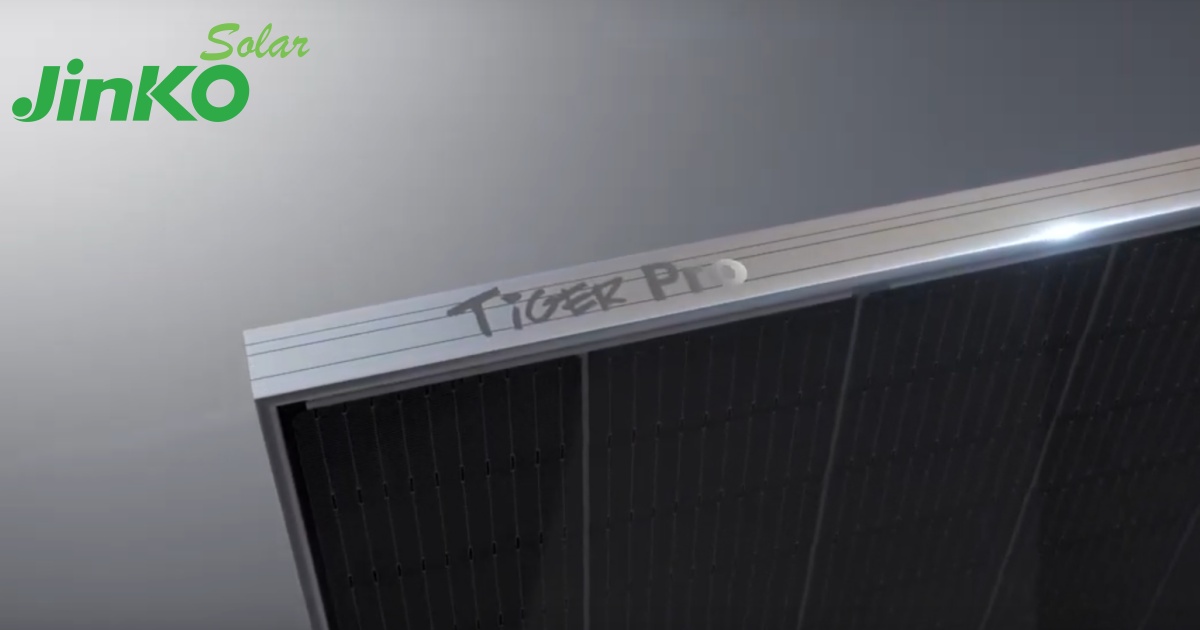JinkoSolar is the latest manufacturer to unveil a 500W+ solar panel – and it boasts significantly more capacity than others recently announced.
The Tiger Pro module series was unveiled through a virtual product launch last week. Four models will be available, with the Tiger Pro 78TR Monofacial offering 580 watts capacity, a conversion efficiency of 21.6% and a temperature coefficient of -0.35%/°C. Temperature coefficient refers to how much power is lost for every °C the panel is hotter than 25°C – and -0.35%/°C is pretty good.
“With various types of modules, Tiger Pro series enables the construction of more powerful and efficient solar power farms that will bring higher return on investment for projects with larger technical and efficiency requirements,” said Kangping Chen, CEO of JinkoSolar.
Mass production of the Tiger Pro series is expected to commence in the third quarter of 2020. You can find out a bit more about the Tiger Pro here; but you may need to scroll down the page a bit – on my system there was a large amount of white space at the top of the page.
Other manufacturers that have recently unveiled 500 watt solar panels include Risen Energy and Trina Solar (Tallmax, DuoMax and Vertex). Trina is already talking about manufacturing a 600W version of the Vertex by adding an extra column of cells.
500W+ Solar Panels And Residential Rooftops
In all cases, these panels have been designed for use in large commercial solar and utility scale PV installations. The panels are not only big on power, but also in size. A conventional 60-cell solar panel is around 1m x 1.65m and a conventional 72-cell module is approximately 1m x 2m. I wasn’t able to find confirmed dimensions, but the new generation of 500W+ solar panels are even larger than this. While 72 cell panels can be installed on residential rooftops, extra care needs to be taken and these even bigger panels might be pushing things a bit.
However, some of the technology used in developing the modules may also be applied to panels for the residential market, so higher capacity solar panels for home use are certainly on the horizon. There are already smaller-format 400 watt panels available in Australia for residential use, manufactured by SunPower – the Maxeon 3 (1.69m x 1.04m, weight: 19kg). It looks like Seraphim also has a 400W module available here, the Blade, but that is 2m x 1m and weighs in at 23kg.


 RSS - Posts
RSS - Posts



Will such size allow the useful life to be extended well beyond what is now on the market?
This “bigger bigger bigger” thing is kind of a joke. They’re not better, they’re not more efficient, they’re simply… Bigger. This 580W panel will need ~2.7m^2, meaning it will be ~2.45m tall and ~1.1m wide.
Unless the actual technology involved in making the individual cells has improved significantly, getting the bigger and higher capacity panels is probable not worth the quite significant extra cost involved. have recently had a system installed and was seriously looking at the Sepherims 400W panels v’s their 330W panels, until it was brought to my attention that the larger panels had exactly the same cells as the smaller panel, just a few more of them. Thus it wasnt going to be any more efficient, it would have just taken up a little less roof space and cost me an extra thousand dollars.
Perhaps there is a little of both going on here ( bigger size and better efficiency ) . 10y ago 17% efficiency was more or less normal now manufacturers are often quoting efficiencies of close to 22% . now sneaky measurement tricks withstanding . On face value that means per square meter we are producing about 30% more electricity. A new (22%) panel the same size as an old (17%) 250W panel is now more like a 320W panel . or put another way a modern 500W panel need only be 1.5 times larger than an old 250 watt panel ( not twice as large as you may expect) . I’m no longer in the industry and these new efficiency figures seem fantastic so i’ll be very interested to get the actual dimensions of some of these newer > 500w panels